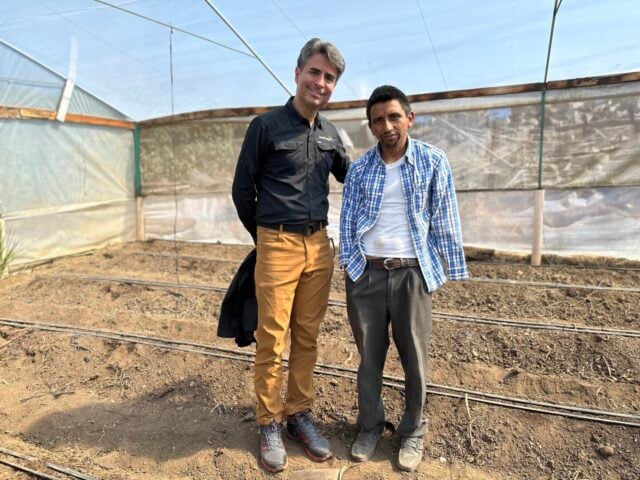A reforestation project that has restored thousands of hectares of land in southwestern Ethiopia has won global recognition by becoming the first on the continent to earn United Nations-administered carbon credits.
The success of the project suggests it will become a model for similar endeavors around the globe, with the potential to remove millions of tons of harmful greenhouse gasses from the atmosphere.
The Humbo Assisted Natural Regeneration project, managed by World Vision and the Ethiopian Forestry Department, inspired local residents to rehabilitate more than 2,700 hectares of barren land.
Three decades ago the same land was covered with dense jungle and was home to several animal species. But unrestrained hacking of trees for firewood, charcoal, and furniture scared away the wildlife and turned a lush forest into a denuded wasteland.
Without the protection offered by trees and ground vegetation, the soil eroded and runoff flooded low-lying areas. Farmland was blanketed with silt and boulders. Agricultural production in the area fell by 70%.
Trees no longer broke up the soil to allow water to descend into underground aquifers, threatening groundwater reserves for 65,000 people.
Since 2006, local forest management committees reversed the decline by using Farmer-Managed Natural Regeneration (FMNR) — a technique pioneered and refined by World Vision in West Africa.
FMNR relies on the selection, care, and pruning of existing tree root material. With careful stewardship, trees and grassland returned to Humbo within three years.
This month, Humbo residents were awarded 73,000 credits under the United Nation’s Clean Development Mechanism, representing the successful capture of 73,000 metric tons of carbon dioxide.
These credits can be sold to industrialized countries to help them fulfill their obligations to reduce greenhouse gas emissions.
The credits will provide an expected income stream of more than $700,000 to local communities for at least the next 10 years.
The money is being reinvested in grain storage sheds, the construction of a flour mill, and enterprises such as beekeeping.
Tony Rinaudo, World Vision’s research and development specialist on climate and natural resources, says the social, environmental, and economic benefits of these projects will attract more carbon buyers and increase the chance of more Humbo-style projects in the future.
“Humbo itself has highlighted the efficacy of FMNR to the point where the Ethiopian government has announced it will replicate Humbo-style projects on 15 million hectares — with or without carbon funding,” he says.
Encouraged by Humbo’s success, World Vision is establishing FMNR projects in several other countries in East Africa.
“We expect a very significant benefit to accrue to large populations in a relatively short period,” Tony says.
The World Agroforestry Center — an international research organization — has also made FMNR projects a top priority and is seeking to partner with World Vision to implement them around the globe.
“Given the state of the world’s environment, it’s not too soon,” Tony says.

Forest reclaimed from barren land
For years, Aster Tantu and her family were hungry for six months each year.
Their 2.5 acres of land near Humbo, Ethiopia, yielded just 440 pounds of corn each year — not nearly enough to feed the family, let alone sell for income during the lean season.
“My family of seven did not get even one meal a day,” says Aster, 35.
Aster’s life and land are vastly different now, thanks to an ancient cultivation method World Vision and forest management committees revived in her area. FMNR has helped Aster and thousands of Humbo residents rehabilitate more than 6,600 acres of barren land since 2006.
Humbo’s forest grew back so well, it became the first community in Africa to earn United Nations-administered carbon credits, capturing thousands of tons of carbon dioxide. The credits generate about $70,000 per year for Humbo.
“I and many of our villagers have been able to have enough food on the table, send our children to school, and even breathe cold air, as the area has become more and more cool,” Aster says.
Once a lush jungle, the land surrounding Humbo had become barren in recent decades from unrestrained hacking of trees for charcoal, firewood, and furniture.
Without the protection offered by trees and ground vegetation, the soil eroded, and runoff flooded low-lying areas. Farmland was blanketed with silt and boulders. Agricultural production in the area fell by 70%.
Trees no longer broke up soil to allow water to descend into underground aquifers, threatening groundwater reserves for 65,000 people.
Communities around the world have a similar story.
“It makes me very sad because, unlike natural disasters or some conflict situations, poverty and hunger caused by environmental degradation is totally avoidable and occurs over long time frames,” says Tony Rinaudo, World Vision’s research and development specialist on climate and natural resources.
But within a couple of years of teaching farmers how to manage the land with FMNR, soil fertility was restored, water sources rejuvenated, the weather cooled, wildlife returned, and families doubled their crop yields or more.
Ethiopia’s government is applying Humbo’s model to help restore up to 37 million acres of depleted land nationwide.
“What’s needed, much more than a technical innovation or an injection of large amounts of funding, is simply a change in the way people manage the land,” Tony says. “And understanding that everything that people need to restore the land is already there.”
The success in Humbo has led World Vision to teach communities these methods in 20 countries. Farmers who once struggled with insufficient harvests now reap abundant benefits through patient, thoughtful stewardship. And they’re naturally teaching their friends and neighbors these practices.
A simple, timeless concept has become a tool for farmers to achieve their aspirations of raising their children to be healthy, educated, and good stewards of the land.
“People want a better life for their children,” Tony says. “It frees them from being hopeless victims of poverty and climate change. In many ways, it restores their dignity.”
James Addis of World Vision’s staff in the U.S. contributed to this article.




